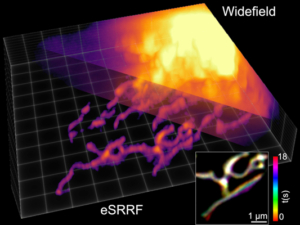The power to turn the invisible visible
Researchers at the Gulbenkian Science Institute have unleashed an innovative breakthrough in microscopy— eSRRF (enhanced Super-Resolution Radial Fluctuations). This cutting-edge method, now published in Nature Methods, furthers our understanding of biological systems through live-cell imaging, offering a glimpse into the microscopic world with unparalleled clarity and precision.
Imagine having a microscope that magnifies and enhances the tiniest details, revealing a world beyond the limits of conventional resolution. That’s precisely what eSRRF brings to the scientific forefront—an upgraded super-resolution magic wand for microscopes. Building upon the success of the SRRF method, eSRRF is not just an evolution; it’s a revolution. It takes microscopic imaging to the next level, delivering enhanced fidelity to the underlying structures and resolutions. eSRRF is brilliant, with automated data-driven parameter optimization. It determines the optimal number of frames needed for reconstruction, providing scientists hassle-free and efficient imaging experience.
Furthermore, eSRRF transcends dimensions by teaming up with multi-focus microscopy, leading to an era of 3D super-resolution. Imagine capturing volumetric snapshots of live cells at a breathtaking speed of approximately one volume per second. That´s what the team developed.

3D live-cell super-resolution imaging with eSRRF: Mitochondria dynamics observed in U2OS cells expressing TOM20-Halo, loaded with the fluorescent marker JF54, with a multi-focus microscope are super-resolved by 3D eSRRF processing of the dataset. This allows a super-resolved volumetric view of 20 x 20 x 3.6 μm3 at a rate of ~1Hz in a living cell.
Considering research openness and easy usability, eSRRF is designed with user-friendliness, seamlessly integrating with various microscopy techniques and biological systems, and researchers can now explore the microscopic realm without technological barriers.
Hannah Heil, the paper’s first author, explains that “eSRRF opens up new possibilities in live-cell imaging. It’s not just about enhancing image resolution; eSRRF empowers researchers to optimize results based on quantitative image quality measures. Our method provides researchers with a dynamic tool that adapts to their needs, making the invisible visible.”
Ricardo Henriques, leading the Optical Cell Biology research group at the IGC, reveals that this new method “is a window into the future of scientific exploration. eSRRF can potentially revolutionize several fields, from biology to medicine, paving the way for discoveries that were once beyond our visual reach”.
The Gulbenkian Foundation, the European Research Council, the European Commission, the European Molecular Biology Organization, the Wellcome Trust, Fundação para a Ciência e Tecnologia, and the Chan Zuckerberg Initiative supported this project.
Read Paper